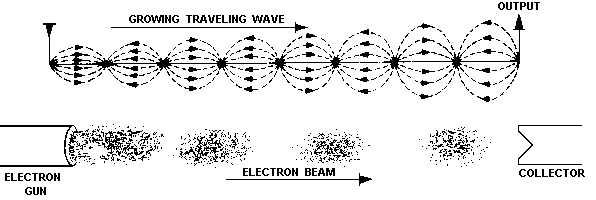2-21
wide range of rf frequencies if it is terminated in the characteristic impedance of the line. The
electromagnetic waves traveling down the line produce electric fields that interact with the electrons of
the beam.
Figure 2-14.—Simplified twt.
If the electrons of the beam were accelerated to travel faster than the waves traveling on the wire,
bunching would occur through the effect of velocity modulation. Velocity modulation would be caused
by the interaction between the traveling-wave fields and the electron beam. Bunching would cause the
electrons to give up energy to the traveling wave if the fields were of the correct polarity to slow down the
bunches. The energy from the bunches would increase the amplitude of the traveling wave in a
progressive action that would take place all along the length of the twt, as shown in figure 2-14.
However, because the waves travel along the wire at the speed of light, the simple twt shown in
figure 2-14 will not work. At present no way is known to accelerate an electron beam to the speed of
light. Since the electron beam cannot travel faster than the wave on the wire, bunching will not take place
and the tube will not work. The twt is therefore designed with a delay structure to slow the traveling wave
down to or below the speed of the electrons in the beam. A common twt delay structure is a wire, wound
in the form of a long coil or helix, as shown in figure 2-15, view (A). The shape of the helix slows the
effective velocity of the wave along the common axis of the helix and the tube to about one-tenth the
speed of light. The wave still travels down the helix wire at the speed of light, but the coiled shape causes
the wave to travel a much greater total distance than the electron beam. The speed at which the wave
travels down the tube can be varied by changing the number of turns or the diameter of the turns in the
helix wire. The helical delay structure works well because it has the added advantage of causing a large
proportion of electric fields that are parallel to the electron beam. The parallel fields provide maximum
interaction between the fields and the electron beam.

